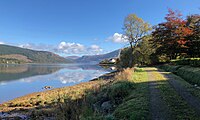Loch Fyne
| Loch Fyne | |
|---|---|
 Head of the loch from near St Catherines | |
| Location | Cowal, Argyll and Bute, Scotland. |
| Coordinates | 56°10′19″N 5°06′00″W / 56.172°N 5.100°W / 56.172; -5.100Coordinates: 56°10′19″N 5°06′00″W / 56.172°N 5.100°W / 56.172; -5.100, grid reference NN0765202128 |
| Type | Sea Loch |
Basin countries | Scotland, United Kingdom |
| Surface elevation | Sea Level |
| Frozen | No |
Loch Fyne (Scottish Gaelic: Loch Fìne, pronounced [l̪ˠɔx ˈfiːnə]; meaning "Loch of the Vine/Wine"), is a sea loch off the Firth of Clyde and forms part of the coast of the Cowal peninsula. Located on the west coast of Argyll and Bute, Scotland. It extends 65 kilometres (40 mi) inland from the Sound of Bute, making it the longest of the sea lochs. It is connected to the Sound of Jura by the Crinan Canal. Although there is no evidence that grapes have grown there, the title is probably honorific, indicating that the river, "Abhainn Fìne", was a well-respected river.
In the north the terrain is mountainous, with the Arrochar Alps, Beinn Bhuidhe, Glen Shira, Glen Fyne, Glen Croe, Arrochar, Tyndrum and Loch Lomond nearby.
It is overlooked by the Tinkers' Heart, an old travelers' monument.[1]
Loch Fyne is a popular area for sport diving and fishing. It is also a popular tourist destination with attractions such as Inveraray Castle and the nearby ruins of Castle MacEwen and Old Castle Lachlan.
The village of Portavadie is on the east shore of the loch. A passenger ferry traverses the loch to Tarbert from the slipway at Portavadie.
Dolphins, seals and otters inhabit the loch, and basking sharks can appear in its waters during the summer months. A Ross's gull was present at the loch in early 2007.

Loch Fyne in Scotland
Contents
1 Crinan Canal
2 Fisheries
3 World War II
4 Gallery
5 See also
6 References
7 External links
Crinan Canal

The Crinan Canal at Bellanoch
The Crinan Canal connects Loch Fyne at Ardrishaig and the Sound of Jura at the hamlet of Crinan itself, giving a shortcut for smaller vessels out to the Hebrides saving the longer route of going around the Kintyre peninsula. The canal was built between 1794 and 1801 when the canal was opened, under the supervision of John Rennie. In 1816 Thomas Telford redesigned parts of the canal to remedy technical issues with water supplies for the canal. There are fifteen locks along the canal's 9-mile (14 km) length.[2]
Fisheries
Loch Fyne has a reputation for its oyster fishery, and as a consequence, the loch has given its name to the once locally owned Loch Fyne Oysters and to the associated Loch Fyne Restaurants.[3] It is also notable for its herring-fishing industry, and hence the famous Loch Fyne Kipper, originally caught using the drift-net method. In the mid-19th century, Loch Fyne was the center of the battle between the traditional drift-net fishermen and the new trawl-net fishermen who sprang up around Tarbert and Campbeltown in 1833.[4]
Several Scottish sea-fishing records have been set in the loch:
| Species | Weight lb-oz-dr | Angler | Date | Method |
|---|---|---|---|---|
| Dogfish black mouthed | 02-13-08 (1.29 kg) | J. H. Anderson | 1977 | Boat |
| Poor cod | 01-00-00 (0.45 kg) | F. Johnstone | 1970 | Shore |
| Tadpole fish | 01-04-00 (0.57 kg) | H. Donnelly | 1995 | Shore |
| Blue whiting | 01-12-00 (0.79 kg) | J. H. Anderson | 1977 | Boat |
World War II

A lecture at HMS Quebec in Inverary
Around a quarter of a million troops trained at HMS Quebec, No.1 Combined Training Centre, Inveraray in amphibious-landing techniques on the shores of Loch Fyne prior to the D-Day landings.
Some 30 senior officers, each with a staff vehicle and radio also took part in a top secret deception exercise to convince the Germans that a major sea assault was being prepared but could not be launched until at least September 1944.[5][6]
Gallery

Inveraray Bridge on Loch Fyne. The spires of Inveraray Castle can just be seen on the left.

Loch Fyne at Inverary harbour.

A view towards the north-eastern tip of the loch from St Catherines.
The view down Loch Fyne, from Inveraray. The Fairy Hill can be seen in the distance to the right.
See also
- Ardkinglas Railway
References
^ "MSPs seek action over Tinkers' Heart in Argyll". BBC News. 2014-09-30. Retrieved 2016-12-14..mw-parser-output cite.citation{font-style:inherit}.mw-parser-output .citation q{quotes:"""""""'""'"}.mw-parser-output .citation .cs1-lock-free a{background:url("//upload.wikimedia.org/wikipedia/commons/thumb/6/65/Lock-green.svg/9px-Lock-green.svg.png")no-repeat;background-position:right .1em center}.mw-parser-output .citation .cs1-lock-limited a,.mw-parser-output .citation .cs1-lock-registration a{background:url("//upload.wikimedia.org/wikipedia/commons/thumb/d/d6/Lock-gray-alt-2.svg/9px-Lock-gray-alt-2.svg.png")no-repeat;background-position:right .1em center}.mw-parser-output .citation .cs1-lock-subscription a{background:url("//upload.wikimedia.org/wikipedia/commons/thumb/a/aa/Lock-red-alt-2.svg/9px-Lock-red-alt-2.svg.png")no-repeat;background-position:right .1em center}.mw-parser-output .cs1-subscription,.mw-parser-output .cs1-registration{color:#555}.mw-parser-output .cs1-subscription span,.mw-parser-output .cs1-registration span{border-bottom:1px dotted;cursor:help}.mw-parser-output .cs1-ws-icon a{background:url("//upload.wikimedia.org/wikipedia/commons/thumb/4/4c/Wikisource-logo.svg/12px-Wikisource-logo.svg.png")no-repeat;background-position:right .1em center}.mw-parser-output code.cs1-code{color:inherit;background:inherit;border:inherit;padding:inherit}.mw-parser-output .cs1-hidden-error{display:none;font-size:100%}.mw-parser-output .cs1-visible-error{font-size:100%}.mw-parser-output .cs1-maint{display:none;color:#33aa33;margin-left:0.3em}.mw-parser-output .cs1-subscription,.mw-parser-output .cs1-registration,.mw-parser-output .cs1-format{font-size:95%}.mw-parser-output .cs1-kern-left,.mw-parser-output .cs1-kern-wl-left{padding-left:0.2em}.mw-parser-output .cs1-kern-right,.mw-parser-output .cs1-kern-wl-right{padding-right:0.2em}
^ "Crinan Canal Feature Page on Undiscovered Scotland". Undiscoveredscotland.co.uk. Retrieved 2017-02-03.
^ Dunkley, Daniel (2016-03-27). "Loch Fyne on the block". The Sunday Times.
^ The Rinn-Net Fishermen, Martin
^ "No. 1 COMBINED TRAINING CENTRE, INVERARAY". Combinedops.com. Retrieved 2017-02-01.
^ "Major General Desmond Mangham - obituary". Daily Telegraph. 17 December 2014. Retrieved 19 December 2014.
External links
Map sources for Loch Fyne
- Old Castle Lachlan - website
- Gaelic place names of Scotland - website
- Combined Operations Command - website
| Wikimedia Commons has media related to Loch Fyne. |



